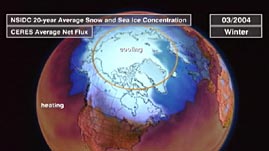Teachers' Domain - Digital Media for the Classroom and Professional Development
User: Preview

Source: NASA/Goddard Space Flight Center Scientific Visualization Studio



This video segment adapted from NASA uses satellite imagery to provide an overview of the cryosphere in the northern hemisphere, including the Arctic. Investigate the cryosphere's role in North America, the extent of permafrost in the northern hemisphere, and how the polar regions play a role in regulating global climate. Finally, observe changes in Arctic ice cover, such as the decrease in summer sea ice over the past few decades and changes in the flow rate of Greenland's Jakobshavn Glacier.
The cryosphere—all the frozen areas on Earth's surface where water exists in its solid form (such as sea ice, ice shelves, icebergs, ice sheets, glaciers, lake ice, river ice, snow, and permafrost)—is an integral part of the Earth system. For example, because snow and ice reflect more radiation than they absorb, the polar areas, which consist primarily of snow and ice, have a cooling effect on Earth and play an important role in global temperature regulation. The cryosphere also influences global ocean and atmospheric circulation patterns.
While the majority of the world's snow and ice is located at Earth's poles (Antarctica alone has about 85 percent of the world's ice), the cryosphere is not limited to the polar regions. For instance, permafrost—land that is below 0°C for two or more years—exists at high elevations in latitudes far from the poles. Similarly, glaciers are found on mountaintops around the world, even in the tropics. Furthermore, millions of people who reside in middle and low latitudes experience the cryosphere as snowfall and seasonally or intermittently frozen ground; seasonally frozen ground covers approximately 55 percent of the northern hemisphere's land surface.
In the middle and low latitudes, the cryosphere is less permanent and less dominant than at the poles, but it still has a significant impact on Earth processes, such as the hydrological cycle. For example, snow and ice cover affect surface evaporation, and permafrost influences runoff and groundwater storage. In addition, the melting of mountain snowpack provides water for vegetation growth and replenishes the freshwater supply by recharging reservoirs; winter snow also stores water that decreases the risk of drought and forest fires in summer months.
Because of the interrelationships between the cryosphere and other parts of the Earth system, any change in the cryosphere will have implications for climate worldwide. To better understand and predict the potential impact of global warming on the cryosphere, scientists use satellite technology to gather data about the polar regions and other remote areas. With the help of electromagnetic sensors and radar systems onboard satellites above Earth's surface, scientists make large-scale observations of the planet that enable them to conduct studies of climate change on a global scale.
 Loading Standards
Loading Standards Teachers' Domain is proud to be a Pathways portal to the National Science Digital Library.
Teachers' Domain is proud to be a Pathways portal to the National Science Digital Library.
